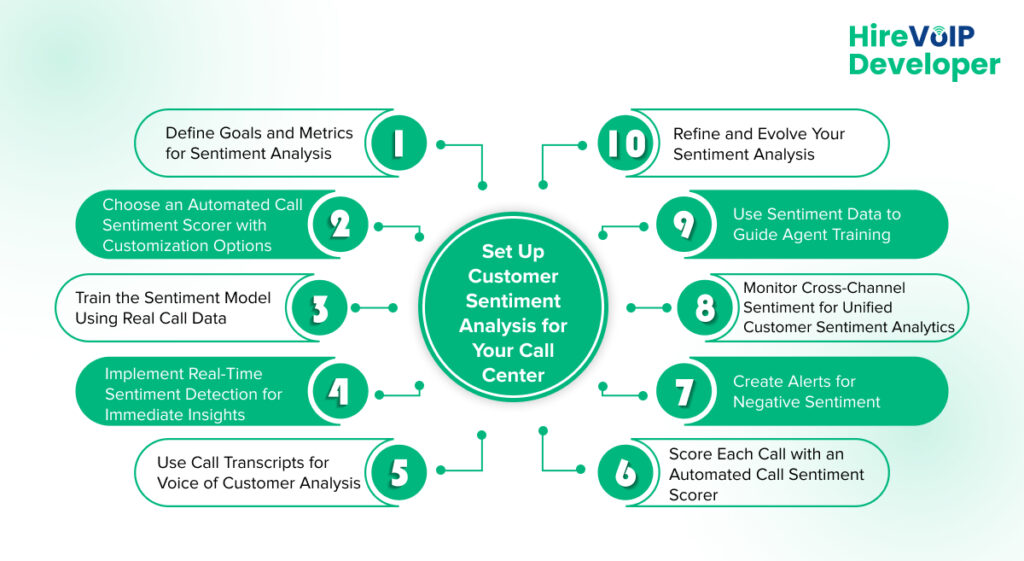Summary:
Are you curious about the potential of customer sentiment analytics in your call center? This guide provides ten actionable steps for customer sentiment analysis, helping you make your customers happier and make data-driven decisions!
Knowing what your customers feel—not just what they say—can make all the difference in a call center. Customer sentiment analytics allows you to interpret emotional cues from customer interactions, helping your team respond more effectively and making it easier to improve customer satisfaction and loyalty.
Before we move further, let’s talk about why you need to care about customer sentiment analytics.
Businesses that prioritize customer experience can achieve up to 60% higher profits than competitors that do not—a clear indication of the value that lies in truly understanding and responding to customers’ emotions.
With tools like automated call sentiment scorers and real-time sentiment detection, your call center can create a more personalized, adaptive, and responsive experience.
Here’s how to analyze customer sentiments in your call center, step by step.

Step 1: Define Goals and Metrics for Sentiment Analysis
Before starting with sentiment analytics, set clear goals to guide the process. Decide what you aim to achieve. Some common goals include:
- Increasing customer satisfaction: Measure how sentiment analysis impacts your CSAT (customer satisfaction score) scores.
- Reducing escalations: Use sentiment data to detect when interactions might turn negative, allowing for timely interventions.
- Improving agent training: Identify sentiment trends to help train agents on handling various emotional cues.
Once goals are set, define the metrics that align with them, such as average sentiment score, positive vs. negative sentiment ratio, or reduction in escalations. Establishing clear KPIs ensures your team knows what success looks like and how to measure it effectively.
Step 2: Choose an Automated Call Sentiment Scorer with Customization Options
An effective automated call sentiment scorer provides real-time, actionable insights. Choose a tool that supports real-time sentiment detection, integrates with your call center and CRM platforms, and has NLP and machine learning capabilities. Ideally, look for a solution that offers:
- Multi-language support for global teams.
- Customizable parameters so you can fine-tune sentiment thresholds based on your business needs.
- Scalable infrastructure that grows with your call center, handling increasing volumes without losing accuracy.
With the right tool, you can use the voice of your customer for analysis by capturing real-time emotional cues, providing feedback, and adapting to changing customer language trends.
Step 3: Train the Sentiment Model Using Real Call Data
Out-of-the-box AI models may not fully capture the nuances of your customer interactions. Training the model with real historical data ensures it understands the specific language, tone, and context relevant to your industry.
- Curate a diverse data set: Use calls that reflect different emotions (frustration, satisfaction, curiosity) to give the model a broad foundation.
- Add industry-specific language: For instance, a finance company may encounter terms like “overdraft” or “interest rates,” which the AI should recognize in sentiment contexts.
- Refine regularly: As customer behavior changes over time, continue adding recent data to keep the model accurate.
Proper training enables the model to recognize even subtle emotional cues, boosting the accuracy of your customer service sentiment analysis.
Drive loyalty with smarter decisions—use customer sentiment analysis!
Step 4: Implement Real-Time Sentiment Detection for Immediate Insights
With real-time sentiment detection, agents receive feedback on customer emotions as calls happen. This feedback empowers agents to adjust their approach during a call, helping diffuse tense situations before they escalate. It also provides supervisors with live insights so they can intervene in high-stakes conversations if necessary.
- Set specific alert levels: Define thresholds that trigger alerts for different sentiment scores, notifying agents or supervisors of at-risk calls.
- Empower agents with training: Ensure agents understand how to use these insights and provide clear guidance on how to adapt based on real-time sentiment feedback.
Real-time sentiment data isn’t just about tracking emotions—it’s about using those insights to make calls smoother and more positive for customers and agents alike.
Step 5: Use Call Transcripts for Voice of Customer Analysis
Transcripts provide a rich resource for analyzing your customer’s voice. They allow you to identify patterns in customer needs, preferences, and frustrations. By reviewing transcripts, you can capture valuable information that’s easy to miss during live interactions.
- Set Up keyword filters: Identify terms or phrases that indicate key topics or recurring pain points, like “billing issues” or “account update.”
- Analyze sentiment by topic: See how sentiment trends across different topics, helping you spot areas where customers may be experiencing repeated frustrations.
- Compare against sentiment scores: Cross-reference transcript data with sentiment scores for a deeper understanding of both content and emotional tone.
This data supports product development, policy changes, and customer service improvements by giving you a grounded view of what’s impacting customer satisfaction.
Step 6: Score Each Call with an Automated Call Sentiment Scorer
A sentiment score provides a clear metric for each call, capturing the emotional tone and highlighting trends over time. A good automated call sentiment scorer evaluates factors like tone, word choice, and call flow to give a score that reflects customer mood. You can use these scores to:
- Identify patterns: Track whether sentiment scores are improving over time and compare with other KPIs.
- Spot pain points: Low scores across similar topics might indicate systemic issues that need attention.
- Enhance reporting: Aggregate sentiment scores can be used in monthly or quarterly reports to showcase customer satisfaction trends.
By consistently scoring calls, you gain a reliable measure of customer satisfaction and areas for improvement.
Step 7: Create Alerts for Negative Sentiment
Sentiment analysis is most valuable when it leads to timely action. Automated alerts for negative sentiment scores allow agents and supervisors to act quickly on difficult calls. Here’s how to set up an effective alert system:
- Define thresholds: Establish sentiment score thresholds that trigger alerts for agents or supervisors based on the level of negativity.
- Customize response protocols: Different types of alerts may need different responses. For example, an agent could receive guidance on calming techniques for mild negativity, while a supervisor might be alerted to intervene in highly negative calls.
- Regularly review alert effectiveness: Assess if the alerts are achieving desired outcomes, like reduced escalations, and adjust thresholds or responses accordingly.
Automated alerts help maintain control over customer interactions, particularly when emotions run high.
Step 8: Monitor Cross-Channel Sentiment for Unified Customer Sentiment Analytics
Call centers rarely operate on phone calls alone. For a comprehensive view of customer sentiment, expand customer sentiment analytics across all customer service channels, including chat, email, and social media. This approach enables higher-ups to pinpoint which channels need improvement and identify if negative sentiment in one channel is affecting overall experience.
- Use channel-specific analytics: Measure sentiment on each channel individually, then aggregate for a big-picture view.
- Identify cross-channel trends: If email and chat show frequent negative sentiment, for instance, that could indicate a broader issue with response times or information clarity.
- Align channel strategies: Use the data to align resources, streamline processes, and ensure all channels contribute positively to customer experience.
Step 9: Use Sentiment Data to Guide Agent Training
Sentiment analysis provides valuable insights for ongoing agent training, helping agents better recognize and respond to customer emotions. Here’s how to use this data for training effectively:
- Highlight top-scoring calls: Share high-scoring calls to show effective techniques for handling different emotions.
- Review low-scoring calls: Identify common behaviors or phrases that lead to low scores, helping agents understand areas to improve.
- Focus on emotional intelligence: Encourage agents to use sentiment feedback to understand customer cues better and adapt their style accordingly.
Agents can better understand customer needs and adapt their approach by incorporating sentiment analysis into training, leading to a more empathetic and efficient call center.
Step 10: Refine and Evolve Your Sentiment Analysis
Sentiment analysis isn’t a one-time setup; it requires regular refinement to keep pace with changing customer expectations. Here’s how you can stay agile:
- Review thresholds quarterly: Update sentiment thresholds to reflect current customer language and expectations.
- Incorporate new language trends: Keep the model updated with language or expressions your customers start using over time.
- Benchmark against industry standards: Compare your sentiment scores with industry benchmarks to see where you stand and adjust as needed.
Continuous improvement ensures your sentiment analysis remains relevant and responsive, ready to meet evolving customer needs.
(Also learn: How Does A Unified Communication System Optimize Customer Experience?)
Integrating customer sentiment analytics transforms how your call center understands and serves customers. By following these ten steps, you can create a call center experience that adapts in real-time to your customer’s emotions, builds stronger relationships, and makes every interaction count.
Boost customer satisfaction and profits with sentiment analytics in your call center!
Ready to elevate your customer service?
Let Hire VoIP Developer help you build a call center solution tailored for real-time customer sentiment analysis to help your business grow!



